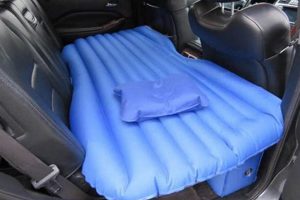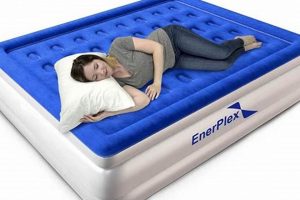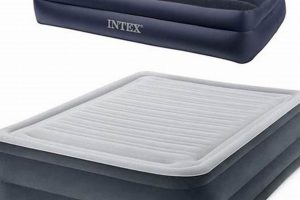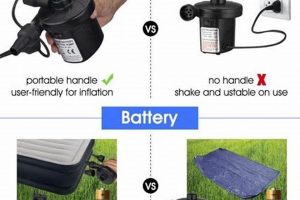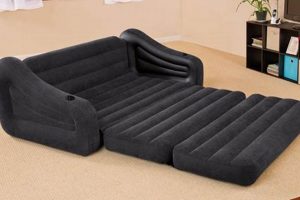Addressing punctures in inflatable sleeping surfaces necessitates a systematic approach. This process typically involves identifying the precise location of escaping air, followed by the application of a sealant or patching material to restore the integrity of the airtight chamber. Failure to address such breaches results in a gradual deflation, compromising the comfort and functionality of the item.
Maintaining the functionality of these portable bedding solutions ensures continued usability, particularly during travel, camping, or accommodating overnight guests. Historically, solutions have ranged from rudimentary adhesives to specialized repair kits designed for flexible materials. Preserving the utility of this item represents a cost-effective alternative to replacement, promoting responsible consumption and minimizing waste.
The following sections will delve into specific methods for locating and rectifying these punctures, outlining the necessary tools and materials, and providing step-by-step instructions for implementing effective and lasting solutions. Different techniques, ranging from simple solutions to comprehensive overhauls, will be covered.
Tips for Addressing Air Mattress Deflation
Effective management of air mattress punctures requires careful preparation and execution. The following guidelines offer practical strategies for identifying, repairing, and preventing issues that lead to air leakage.
Tip 1: Conduct a Thorough Inspection: Prior to any repair attempt, meticulously examine the entire surface of the mattress, paying close attention to seams, valves, and areas of frequent contact. Visual cues, such as surface distortions or bubbling, can indicate the location of escaping air.
Tip 2: Employ a Soapy Water Solution: Combine water with a small amount of dish soap. Apply the solution liberally to the mattress surface. The presence of bubbles will pinpoint the exact location of the leak. Mark the area clearly for subsequent repair.
Tip 3: Utilize Appropriate Patching Materials: Repair kits designed specifically for inflatable mattresses offer the most reliable solution. Avoid using generic adhesives or tapes, as they may not provide a secure or lasting bond with the mattress material.
Tip 4: Prepare the Surface Adequately: Before applying any patching material, thoroughly clean and dry the affected area. Use isopropyl alcohol to remove any residual oils or dirt. A clean surface ensures optimal adhesion.
Tip 5: Apply Pressure During Curing: After applying the patch, apply consistent pressure to the repaired area for the duration specified in the repair kit instructions. This pressure facilitates a strong bond between the patch and the mattress material.
Tip 6: Consider Interior Patching for Larger Tears: For larger punctures, consider accessing the interior of the mattress, if feasible, to apply a patch to both the inner and outer surfaces. This provides additional reinforcement and reduces the likelihood of future failures.
Tip 7: Implement preventative measures: Regularly inspect the surface where the mattress will be used to make sure there are no sharp items that could cause a puncture. Use a mattress protector for an extra layer of protection.
Implementing these preventative measures and repair techniques can significantly extend the lifespan of an air mattress and ensure continued comfort. Following these tips will result in cost savings and reduced environmental impact.
The subsequent sections will address advanced troubleshooting strategies and explore alternative repair methods for specialized situations.
1. Leak Identification
The imperative to identify air egress points forms the cornerstone of any effort aimed at restoring the integrity of an inflatable mattress. Without accurate detection, remedial actions are rendered ineffective, and the underlying structural compromise persists.
- Auditory Detection
A primary method involves discerning the faint hissing sound emanating from the puncture. This approach is most effective in quiet environments, allowing the auditory system to isolate and localize the source of the leak. However, its utility diminishes in the presence of ambient noise, necessitating supplementary techniques.
- Tactile Examination
Manual exploration of the mattress surface, particularly along seams and stress points, can reveal subtle air currents indicative of an egress point. This technique is often employed in conjunction with auditory detection, providing a more comprehensive assessment of the mattress’s structural integrity. The sensitivity of this method is dependent on the size of the leak and the dexterity of the examiner.
- Soapy Water Application
The application of a soap and water solution creates surface tension conducive to bubble formation at the site of air expulsion. This method provides a visual confirmation of the leak’s location, facilitating precise marking and subsequent repair. The concentration of the solution and the ambient temperature can influence the clarity and longevity of the bubble formations.
- Pressure Differential Analysis
Monitoring the rate of pressure loss within the inflated mattress can provide indirect evidence of a leak’s presence. This approach involves inflating the mattress to a specified pressure and observing the pressure decay over time. While not pinpointing the exact location, this method establishes the need for a more detailed inspection.
These varied identification methods underscore the critical role accurate leak detection plays in the effort to restore air mattress integrity. Each technique offers distinct advantages and limitations, often necessitating a combined approach to ensure thorough assessment and subsequent remediation.
2. Surface Preparation
Surface preparation constitutes a crucial antecedent to any effective attempt to rectify breaches in inflatable mattresses. The presence of contaminants, such as oils, dirt, or residual adhesives, impedes the formation of a strong, enduring bond between the patching material and the substrate. This interference diminishes the efficacy of the repair, potentially leading to premature failure and renewed air leakage. Real-world instances demonstrate that neglecting proper cleaning often results in weak adhesive bonds, requiring subsequent re-application or complete replacement of the compromised mattress. Proper surface preparation is a mandatory component of fixing leaks in this inflatable.
The application of an appropriate cleaning agent, typically isopropyl alcohol, serves to dissolve and remove surface contaminants. Abrasion with a fine-grit sandpaper or similar material may further enhance surface adhesion by creating a more textured profile. This process allows th
e adhesive to mechanically interlock with the substrate, thereby increasing bond strength. In the absence of meticulous surface preparation, even high-quality patching materials will exhibit reduced performance, resulting in unsatisfactory repair outcomes.
In summary, meticulous surface preparation is integral to achieving a durable and reliable repair on an air mattress. Overlooking this essential step compromises the adhesive bond, leading to subsequent air loss and necessitating repeat repair attempts. By prioritizing cleanliness and surface texture, repair efforts are significantly more likely to yield a successful and lasting resolution to the leak.
3. Adhesive Selection
Adhesive selection represents a pivotal determinant in the success of any endeavor to restore the airtight integrity of an inflatable sleeping surface. The chosen bonding agent must exhibit compatibility with the substrate material, typically polyvinyl chloride (PVC) or a similar polymer, while also possessing the necessary tensile strength and flexibility to withstand repeated inflation and deflation cycles. The causal relationship between adhesive properties and repair longevity is direct: inadequate adhesive characteristics invariably lead to premature bond failure and recurring air leakage.
The significance of appropriate adhesive selection extends beyond mere material compatibility. Environmental factors, such as temperature fluctuations and humidity levels, exert considerable influence on adhesive performance. An adhesive formulated for indoor use may exhibit diminished bonding capabilities when exposed to outdoor conditions, necessitating the selection of a more robust, weather-resistant alternative. Furthermore, the adhesive’s curing time and application method must be carefully considered to ensure optimal bond formation and minimize the risk of air pockets or incomplete adhesion. Examples include PVC-specific cements which chemically bond to the air mattress material, offering a stronger and more flexible repair compared to general-purpose glues that may harden and crack over time. The practical significance of understanding these nuances lies in the ability to implement repairs that withstand the rigors of repeated use, thereby extending the lifespan of the inflatable mattress and reducing the need for frequent replacements.
In conclusion, the successful repair of punctures is intrinsically linked to the informed selection of a suitable adhesive. Consideration of material compatibility, environmental factors, and application techniques are essential prerequisites for achieving a durable and reliable bond. By prioritizing appropriate adhesive selection, the overall longevity and performance of repaired inflatable bedding solutions is demonstrably enhanced, thus reinforcing the importance of this critical step.
4. Patch Application
Patch application constitutes a critical step in the process of restoring the integrity of an air mattress following the detection of a leak. The successful adhesion of the patch directly determines the effectiveness of the repair and the subsequent ability of the mattress to maintain its intended inflation level. Inadequate patch application will inevitably result in continued air loss, negating prior efforts to locate and address the puncture.
- Surface Alignment and Coverage
Proper patch application demands precise alignment over the leak site, ensuring complete coverage of the compromised area. Misalignment or insufficient overlap can leave a portion of the puncture exposed, resulting in continued air leakage. For instance, a patch slightly smaller than the damaged area will likely fail to provide a sufficient seal, rendering the repair ineffective. Proper alignment ensures optimal contact between the patch adhesive and the mattress surface. In this context of fixing the leak, a larger patch size is often prefered.
- Air Bubble Elimination
The presence of air bubbles between the patch and the mattress surface compromises the adhesive bond and creates potential pathways for air to escape. Effective patch application necessitates the careful expulsion of any trapped air, typically achieved through the application of firm, even pressure. Failure to eliminate air bubbles results in a weakened repair and increased likelihood of future leakage. A common method to eliminate these bubbles includes using a roller to evenly distribute pressure, ensuring a strong bond that effectively mitigates air leak risks.
- Adhesive Curing Time and Conditions
Adhesive curing time and environmental conditions significantly impact the strength and durability of the patch bond. Adhering to the manufacturer’s specified curing time is crucial for allowing the adhesive to fully set and achieve its maximum bonding strength. Extreme temperatures or humidity levels can interfere with the curing process, potentially leading to a weakened or incomplete bond. For example, applying a patch in cold temperatures may extend the curing time and require supplemental heating to ensure proper adhesion. Curing within these parameters is crucial for a successful patch application and, by extension, success in the effort to fix an air mattress leak.
- Post-Application Testing
Following patch application and adhesive curing, thorough testing is essential to verify the efficacy of the repair. Inflation of the mattress to its recommended pressure, followed by careful monitoring for any signs of air leakage, confirms the integrity of the patch bond. The soapy water test, previously described for leak detection, can be employed to identify any residual leakage around the patch perimeter. Failure to test the repair renders the entire process incomplete and leaves the user uncertain as to whether their leak is properly fixed and how the application can be improved.
The facets of patch application detailed above collectively underscore its central role in fixing air mattress leaks. A meticulous approach to each aspect of the process, from alignment and bubble elimination to adhesive curing and post-application testing, maximizes the likelihood of a successful and durable repair, ensuring the continued usability of the inflatable mattress.
5. Pressure Maintenance
Effective pressure maintenance is inextricably linked to successful air mattress repair. A puncture, irrespective of size, precipitates a pressure differential, leading to air expulsion and subsequent deflation. Consequently, any intervention aimed at rectifying such breaches must address not only the physical closure of the leak but also the restoration and preservation of internal pressure. The inability to sustain the intended pressure renders the repair functionally incomplete, as the mattress remains unable to provide adequate support and comfort. For example, a patch applied without ensuring a complete seal will allow for continued, albeit potentially slower, air leakage, negating the intended outcome of the repair process. In essence, the success of a fix hinges upon its capacity to maintain pressure.
The impact of proper pressure maintenance extends beyond immediate comfort and functionality. Repeated cycles of inflation and deflatio
n place undue stress on the repaired area, potentially leading to premature failure of the patch or adhesive. Maintaining consistent pressure reduces these stresses, thereby extending the lifespan of the repair and preventing recurring air loss. Furthermore, consistent pressure distribution contributes to uniform support across the mattress surface, enhancing sleep quality and minimizing localized pressure points. For instance, a well-maintained mattress with consistent pressure will distribute weight evenly, reducing strain on the repair site and surrounding material, contributing to its overall longevity.
In conclusion, pressure maintenance is not merely a consequence of a successful fix; it is an integral component. Achieving a durable and effective repair necessitates not only addressing the initial leak but also ensuring the long-term preservation of internal pressure. This dual focus enhances the overall performance and lifespan of the air mattress, preventing recurring issues and maximizing user satisfaction. The ability to effectively maintain pressure serves as a definitive measure of a repair’s success, underlining its fundamental importance.
6. Material Compatibility
The selection of appropriate patching and adhesive materials is paramount to achieving a durable and effective repair when addressing leaks in inflatable mattresses. Incompatibility between the patch, adhesive, and the mattress material itself compromises the integrity of the bond, leading to premature failure and recurring air loss. Therefore, a thorough understanding of material properties is essential for successful remediation.
- Substrate Composition and Patch Material
Air mattresses are typically constructed from polyvinyl chloride (PVC) or thermoplastic polyurethane (TPU). The selected patch material must exhibit similar physical and chemical properties to ensure proper adhesion. For instance, using a non-PVC patch on a PVC mattress will likely result in a weak bond due to differing thermal expansion coefficients and chemical inertness. Choosing a patch material that matches or is specifically designed for the mattress substrate is critical for a lasting repair.
- Adhesive Compatibility with Patch and Substrate
The adhesive serves as the bonding agent between the patch and the mattress material. The adhesive must exhibit strong adhesion to both the patch and the substrate, while also maintaining flexibility to accommodate the mattress’s inflation and deflation cycles. An adhesive incompatible with either the patch or the substrate will result in bond failure. For example, cyanoacrylate adhesives (super glue) tend to become brittle and crack when subjected to repeated flexing, making them unsuitable for air mattress repair, despite their strong initial bond strength on some materials.
- Chemical Resistance and Environmental Factors
The selected repair materials must exhibit resistance to chemicals commonly encountered during the mattress’s use, such as cleaning agents or body oils. Moreover, the materials should withstand temperature fluctuations and humidity levels without degrading or losing their adhesive properties. A patch applied with an adhesive vulnerable to hydrolysis, for example, may detach prematurely in humid environments. Selecting repair components with appropriate chemical resistance and environmental stability is essential for long-term repair success.
- Flexibility and Durability
Inflatable mattresses undergo repeated cycles of inflation, deflation, and physical stress during use. The selected patch and adhesive must maintain their flexibility and durability to withstand these stresses without cracking or peeling. Materials that become rigid or brittle over time are prone to failure. For instance, using a hard epoxy resin as an adhesive would likely result in a rigid, inflexible repair that quickly fails under the stress of normal use. Selecting flexible and durable repair materials contributes significantly to the longevity and effectiveness of the repair.
In summary, achieving a durable and reliable fix requires a holistic approach to material selection, considering the compatibility of the patch, adhesive, and mattress substrate. Neglecting material compatibility leads to compromised repairs and recurrent air leakage. Careful consideration of the substrate composition, adhesive properties, chemical resistance, and material flexibility ensures a lasting repair and extends the usable life of the air mattress.
Frequently Asked Questions
The following addresses common inquiries regarding the diagnosis, repair, and prevention of leaks in inflatable mattresses. These answers aim to provide clear and concise guidance for maintaining the integrity and extending the lifespan of these portable bedding solutions.
Question 1: What are the primary causes of air mattress leaks?
Leaks typically arise from punctures caused by sharp objects, stress-induced failures along seams, valve malfunctions, or degradation of the mattress material over time. Understanding the potential sources aids in preventative maintenance.
Question 2: How can a leak in an air mattress be reliably located?
Effective leak detection methods include visual inspection, auditory assessment for hissing sounds, tactile examination for escaping air currents, and the application of a soapy water solution to identify bubble formation at the leak site.
Question 3: Is it feasible to repair a leak in an air mattress, or is replacement always necessary?
Minor punctures and seam separations are often repairable using appropriate patching materials and adhesives. However, extensive damage or valve failures may warrant replacement, especially if the cost of repair exceeds the value of the mattress.
Question 4: What type of adhesive is best suited for repairing air mattress leaks?
Adhesives specifically formulated for bonding to polyvinyl chloride (PVC) or thermoplastic polyurethane (TPU) are recommended, as these materials exhibit superior adhesion and flexibility compared to general-purpose adhesives.
Question 5: How can the likelihood of future air mattress leaks be minimized?
Preventative measures include using a mattress protector, inspecting the sleeping surface for sharp objects, avoiding over-inflation, storing the mattress properly when not in use, and regularly checking for signs of wear and tear.
Question 6: Are there specific environmental conditions that can affect the integrity of air mattress repairs?
Extreme temperatures and humidity levels can compromise the adhesive bond and accelerate material degradation. It’s recommended to avoid prolonged exposure to direct sunlight and store the mattress in a cool, dry environment.
These answers provide a foundational understanding of air mattress maintenance and repair. Adherence to these guidelines can significantly extend the lifespan of these valuable items and reduce the need for frequent replacements.
The following section will address advanced repair techniques for more complex damage scenarios.
Fix Air Mattress Leak
This exploration has detailed the multifaceted nature of addressing punctures in inflatable mattresses. From precise leak identification and meticulous surface preparation to the critical selection of compatible adhesives and the implementation of proper patching techniques, each stage contributes to the ultimate succ
ess of the repair. Furthermore, the importance of consistent pressure maintenance and a thorough understanding of material properties cannot be overstated. Effective implementation of these strategies ensures the restored functionality and extended lifespan of the mattress.
The ability to effectively fix an air mattress leak offers significant benefits, including cost savings and reduced environmental impact. Mastery of these techniques empowers individuals to proactively maintain their equipment, ensuring continued comfort and utility. As such, continued research and refinement of repair methodologies remain essential for optimizing the longevity and performance of inflatable bedding solutions, particularly in situations where replacement is not feasible or desirable.


